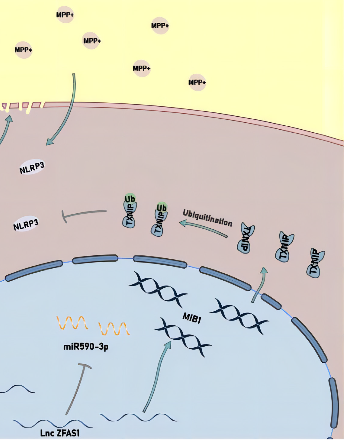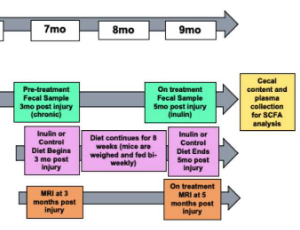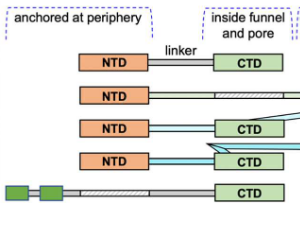Loading
Journal of Cellular Immunology
ISSN: 2689-2812

2022
Volume 4, Issue 2, p34-91
Articles published in this issue are Open Access and licensed under Creative Commons Attribution License (CC BY NC) where the readers can reuse, download, distribute the article in whole or part by mentioning proper credits to the authors.
SARS-CoV-2 Infection: The Viral Arms Race and Pattern- Recognition Receptors
Qi Liu, Sensen Chi, Shuai Tan
Severe Acute Respiratory Syndrome Coronavirus 2 (SARSCoV-2), the causative agent of COVID-19 respiratory disease, was first identified on 7 December 2019, and quickly spread worldwide. The SARS-CoV-2 belongs to Coronaviridea family, enveloped single-stranded RNA viruses. The family is divided into two subfamilies, the Coronavirinae and the Torovirinae, distinguished by the shape of their nucleocapsids . Virions are roughly spherical and are notable for the large spike (S) glycoprotein that mediate viral entry to the host cell. The subfamily Coronavirinae consists of four genera, the alpha-, beta-, gamma-, and delta-coronaviruses. There are seven coronaviruses that can infect people – four of them causing a common cold (229E, NL63, OC43, HKU1), and three are associated with potentially severe respiratory conditions, namely severe syndrome coronavirus (SARS-CoV), Middle East respiratory syndrome coronavirus (MERS-CoV), and the emerging type of SARS-CoV-2, which has 79% sequence homology with SARS-CoV.
J Cell Immunol, 2022, Volume 4, Issue 2, p34-49
Inulin Supplementation Mitigates Gut Dysbiosis and Brain Impairment Induced by Mild Traumatic Brain Injury during Chronic Phase
Lucille M. Yanckello, Brian Fanelli, Scott McCulloch, Xin Xing, McKenna Sun, Tyler C. Hammond, Rita Colwell, Zezong Gu, Aaron C. Ericsson, Ya-Hsuan Chang, Adam D. Bachstetter, Ai-Ling Lin
Approximately 1.6-3.8 million people sustain a mild traumatic brain injury (mTBI) in the US annually. This amounts to the hospitalization of 100-300 per 100,000 young adults. The Centers for Disease Control and Prevention reports that around 5.3 million people live with a permanent disability after mTBI, and there are currently no known restorative therapies.
J Cell Immunol, 2022, Volume 4, Issue 2, p50-64 | DOI: 10.33696/immunology.4.132
Evolution of the RNA Cleavage Subunit C11/RPC10, and Recycling by RNA Polymerase III
Saurabh Mishra, Richard J. Maraia
All cellular RNAs are synthesized by evolutionary related DNAdependent multisubunit RNA polymerases (Pols). Bacteria and archaea each use a single Pol to synthesize all their RNAs whereas a hallmark of eukaryotes is three homologous Pols, I, II and III and the associated Pol-specific transcription factors (TFs) to regulate synthesis of different class RNAs. The Pol III system produces high molar amounts of tRNAs and other small ncRNAs by the efficient reuse of its stable transcription complexes after formation on the promoters of its target genes, and the recycling of Pol III itself.
J Cell Immunol, 2022, Volume 4, Issue 2, p65-71 | DOI: 10.33696/immunology.4.133
LncZFAS1 Inhibit MPP+-Induced Neuroinflammation Through TXNIP/MIB1 E3 Ubiquitin Ligase/NLRP3 Axis
Peiling Huang MM, Weijun Gong MD
Recently researchers have focused on the role of neuroinflammation in neurodegenerative diseases such as Alzheimer’s disease, atrophic lateral sclerosis, Huntington’s disease, Multiple sclerosis and Parkinson’s disease (PD). PD is one of the leading neurodegenerative diseases in developed countries and the complete etiological scenario remains unknown. A-synuclein misfolding and aggregation, mitochondrial dysfunction, dysfunctional protein clearance and ubiquitin/proteasome systems, and neuroinflammation have been associated with PD.
J Cell Immunol, 2022, Volume 4, Issue 2, p72-78 | DOI: 10.33696/immunology.4.134
BIOMODULINA T® Modulates Lymphocyte Compartments in Institutionalized Cuban Geriatric Patients
Imilla Casado Hernandez, Vianed Marsán Suárez, Elizabeth Hernandez Ramos, Yenisey Triana Marrero, Gabriela Diaz Dominguez, Yaneisy Duarte Pérez, Mary Carmen Reyes Zamora, Sahily Estradé Fernandez, Consuelo Amantini, Luis Felipe Heredia Guerra
Aging is accompanied by numerous changes that affect almost all components of the immune system, collectively called immunosenescence. Immunosenescence has long been considered detrimental because it is often accompanied by the subclinical accumulation of pro-inflammatory factors and inflammation. Together, it is suggested that immunosenescence and inflammation are at the origin of most diseases of the elderly, such as infections, cancer, autoimmune disorders and chronic inflammatory diseases. However, a large number of immunogerontologists have changed this negative interpretation of immunosenescence regarding its significance in age-related alterations of the immune system. Considering these changes from an evolutionary perspective, it is preferable to view it as adaptive or remodeling. Although it is conceivable that global immune changes can lead to various diseases, it is also obvious that these changes are necessary for extended survival or longevity.
J Cell Immunol, 2022, Volume 4, Issue 2, p79-91 | DOI: 10.33696/immunology.4.135
Recommended Articles
Role of the Gut Microbiome in the Modulation of Cancer Immunotherapy Response
The gut microbiome or gut flora is a vast community of microorganisms such as bacteria, viruses, protozoa, and fungi that inhabit the digestive tract of the human and other animals [1,2]. In the human body, bacterial species colonize into the oral cavity, skin, vagina, and placenta, however, the largest population of microorganisms resides in the intestine.
No Studies in Stroke Regarding Brain fMRI Activity and Pelvic Floor Muscle Training/Activation - Only Studies in Non-stroke Population: A Review of Neuroimaging Studies
Neurogenic lower urinary tract dysfunction (NLUTD) is highly prevalent in poststroke patients, leading to major impact on the quality of life (QoL) and healthcare resources. Pelvic floor muscle training (PFMT) has, over the past two decades, been recommended as first-line treatment for neurologically healthy patients with lower urinary tract symptoms (LUTS).
Hamstrings Injuries with MRI Findings in a Major League Soccer Team
Hamstring injuries are the most common pathology reported in professional soccer players and represent about 10-30% of all injuries. The hamstring complex is comprised of three muscles located in the posterior compartment of the thigh including the semimembranosus (SM), semitendinosus (ST), and biceps femoris (BF), which is comprised of the long head (BFLH) and short head (BFSH).
Is Cellular Senescence of Dopaminergic Neurons the Cause of Local Inflammation in the Midbrain Observed in Parkinson’s Disease?
Current research investigating the pathomechanisms of neurodegenerative disorders of the central nervous system (CNS), such as Alzheimer’s disease (AD), amyotrophic lateral sclerosis (ALS), or Parkinson’s disease (PD), led to the understanding that these diseases have to be seen in the context of immune responses [1]. In other words,
Comparing Contrast Agent Enhancement: The Value of Artificial Intelligence/Machine Learning
Gadolinium-based contrast agents (GBCAs) work by shortening the T1, T2, and T2* relaxation time constants of adjacent water protons in tissues.
The Mammalian Gut Microbiome, Immune Responses and Disease: From Observational to Causal Relationships
The mammalian gut is the largest organ of adaptive immune responses with a total surface area of 300 m2 of the gut epithelium. The intestinal mucosa contains at least 80% of the body’s activated B cells.
Anti-tumor Mechanisms of Short-chain Fatty Acids, and the Relationship between the Gut Microbiome, Carcinogenesis, Tumor Growth, and Proliferation in Colorectal Carcinoma
We reviewed the anti-tumor mechanisms of short-chain fatty acids (SCFAs) as well as the relationship between the gut microbiome and the pathology of colorectal carcinoma (CRC). According to our in silico analysis of human CRC cell lines, it was shown that SCFAs suppress various genes and transcription factors that participate in tumor growth/proliferation and cell turnover, and butyric acid displayed the strongest inhibitory effects among SCFAs.
Evolution of the RNA Cleavage Subunit C11/RPC10, and Recycling by RNA Polymerase III
All cellular RNAs are synthesized by evolutionary related DNAdependent multisubunit RNA polymerases (Pols). Bacteria and archaea each use a single Pol to synthesize all their RNAs whereas a hallmark of eukaryotes is three homologous Pols, I, II and III and the associated Pol-specific transcription factors (TFs) to regulate synthesis of different class RNAs. The Pol III system produces high molar amounts of tRNAs and other small ncRNAs by the efficient reuse of its stable transcription complexes after formation on the promoters of its target genes, and the recycling of Pol III itself.
LncZFAS1 Inhibit MPP+-Induced Neuroinflammation Through TXNIP/MIB1 E3 Ubiquitin Ligase/NLRP3 Axis
Recently researchers have focused on the role of neuroinflammation in neurodegenerative diseases such as Alzheimer’s disease, atrophic lateral sclerosis, Huntington’s disease, Multiple sclerosis and Parkinson’s disease (PD). PD is one of the leading neurodegenerative diseases in developed countries and the complete etiological scenario remains unknown. A-synuclein misfolding and aggregation, mitochondrial dysfunction, dysfunctional protein clearance and ubiquitin/proteasome systems, and neuroinflammation have been associated with PD.
Capillary Stalling: A Mechanism of Decreased Cerebral Blood Flow in AD/ADRD
Alzheimer’s Disease (AD) and Alzheimer’s Disease-Related Dementias (ADRD) are debilitating conditions that are highly associated with aging populations, especially those with comorbidities such as diabetes and hypertension.
Late Decrease in Cerebral Blood Flow in Bacterial Meningitis: More than a Simple Normalization of Acute Inflammatory Vessel Wall Architecture?
Acute bacterial meningitis is a disease with an overwhelmingly high mortality rate and high incidence of adverse neurological sequelae and poor neurological recovery amongst survivors. Amongst the numerous complications of bacterial meningitis, the presence of cerebrovascular disease represents a severe disease form. Vascular involvement during bacterial meningitis has long been established by numerous pathological and angiographic studies.
Diagnosis and Treatment of Normal Pressure Hydrocephalus and Repeated Subdural Hematoma and Effusion after Ventriculoperitoneal Shunt in the Elderly: A Case Report
Idiopathic normal pressure hydrocephalus (iNPH) is a special type of hydrocephalus that is characterized by cognitive decline, gait disturbance, and urinary incontinence. It can lead to dementia and bedridden within 1-3 years. Without surgical treatment in time, the prognosis was bleak. We report an iNPH case misdiagnosed with Alzheimer’s disease, with a disease course of 3 years.
Optical Insights into Fibrotic Livers: Applications of Near-Infrared Spectroscopy and Machine Learning
Liver fibrosis staging is critical for patient selection and management prior to transplantation, but biopsy is invasive and serum biomarkers lack accuracy. Near-infrared spectroscopy (NIRS) is an emerging non-invasive technology that can detect liver fibrosis via changes in tissue composition. Machine learning (ML) enables analysis of NIRS data for diagnostic modeling.
About Scientific Archives
Scientific Archives is a global publisher initiated with the mission of ensuring equal opportunity for accessing science to research community all over the world. Spreading research findings with great relevance to all channels without any barrier is our goal. We want to overcome the challenges of Open Access with ensured quality and transparency.
